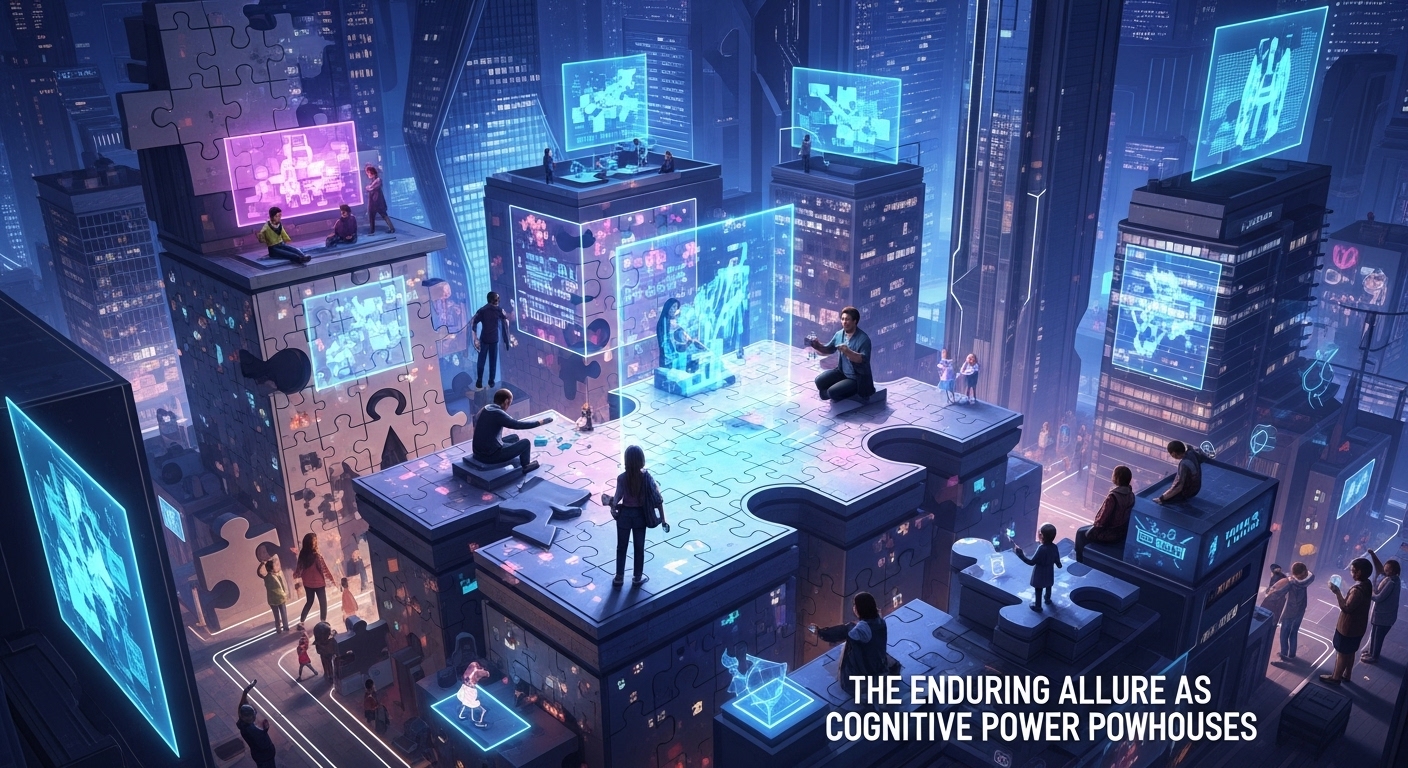In a world increasingly driven by instant gratification and endless streams of content, there remains a deep-seated human pleasure in the slow burn of a challenge, the satisfying click of a solution, and the triumphant “aha!” moment of understanding. This is the realm of the “puzzle” – a game, problem, or toy designed to test a person’s ingenuity, knowledge, or persistence. From ancient riddles whispered around campfires to the sophisticated digital brain-teasers of today, puzzles offer a unique blend of entertainment, profound cognitive exercise, and a powerful sense of accomplishment.
What Makes a Puzzle So Captivating? The Dynamics of Engagement
At its core, a puzzle presents a problem that requires logical thinking, pattern recognition, deduction, or creative insight to solve. They engage our minds in ways that passive entertainment cannot, fostering a sense of active participation. The enduring appeal of puzzles stems from:
- The Inherent Challenge: The fundamental human desire to overcome obstacles and prove one’s mental prowess. Puzzles provide a safe space to test intellectual limits.
- The Rewarding Resolution: The immense satisfaction derived from finally cracking a difficult problem, often accompanied by a surge of dopamine that boosts mood and reinforces the positive experience.
- Intense Mental Stimulation: Puzzles actively engage various cognitive functions, keeping the brain sharp and agile. Research in 2025 continues to highlight how working on puzzles reinforces connections between brain cells, improves mental speed, and strengthens both short-term and working memory.
- Focus and Flow State: The immersive nature of puzzle-solving can lead to a state of “flow,” where distractions fade, and time seems to disappear. This deep concentration offers a welcome respite from daily stressors, providing a meditative quality.
- Universal Accessibility: Puzzles come in countless forms, catering to all ages, skill levels, and preferences, often requiring minimal equipment beyond the puzzle itself.
A Journey Through Puzzle History: From Ancient Enigmas to Digital Wonders
The history of puzzles is as long as human civilization itself. Ancient societies engaged in riddles and logical challenges as forms of entertainment and education.
- Ancient Roots: The Rhind Papyrus (circa 1650 BCE) contains some of the earliest documented mathematical problems. The Stomachion, attributed to Archimedes (3rd century BCE), was a dissection puzzle. Labyrinths and mazes were prominent in ancient Greece and Rome, often integrated into mythology and rituals.
- The Birth of the Jigsaw: In 1766, British cartographer John Spilsbury is credited with inventing the first jigsaw puzzle by cutting maps mounted on wood into pieces for teaching geography. This educational tool quickly expanded to become a popular form of entertainment.
- The Golden Age of Mechanical Puzzles: The late 19th and early 20th centuries saw a boom in mechanical puzzles, including sliding tile puzzles (like the famous 15-puzzle).
- The Rubik’s Cube Era (1980s): The global sensation of the Rubik’s Cube, invented by Ernő Rubik in 1974, combined spatial reasoning with algorithmic thinking and sparked a worldwide craze, inspiring countless variations.
- The Digital Revolution: The advent of computers and the internet transformed the puzzle landscape, giving rise to digital versions of classic puzzles and entirely new genres, from puzzle video games to online escape rooms.
Diverse Genres: A Puzzle for Every Palate in 2025
The world of puzzles is incredibly diverse, offering something for everyone:
- Logic Puzzles: Require deductive reasoning to fill in grids or solve scenarios. Examples: Sudoku, Nonograms (Picross), Logic Grid Puzzles.
- Word Puzzles: Test vocabulary, language skills, and pattern recognition within words. Examples: Crosswords (including cryptic crosswords), Word Searches, Anagrams, Riddles.
- Mechanical Puzzles: Physical objects that must be manipulated to achieve a solution. Examples: Jigsaw Puzzles (including 3D puzzles and increasingly popular wooden variants), Rubik’s Cube and its variants, disentanglement puzzles (wire puzzles), burr puzzles.
- Mathematical Puzzles: Rely on numerical relationships and arithmetic. Examples: KenKen, Kakuro, number sequences.
- Tour Puzzles: Involve finding a path through a network or space. Examples: Mazes, Knight’s Tour (from chess).
- Puzzle Video Games: Integrate puzzle-solving as core gameplay mechanics within digital environments. Examples: Tetris Effect: Connected (for its audiovisual immersion), Monument Valley series (for architectural manipulation), The Witness (for environmental puzzle design), and popular mobile series like The Room. This genre continues to experience steady growth, with puzzle games on Android leading in download volume in Q2 2025.
The Cognitive Powerhouse: Benefits Beyond Mere Entertainment
Beyond sheer enjoyment, engaging with puzzles offers significant cognitive benefits that contribute to overall brain health and daily functioning:
- Enhances Problem-Solving Skills: Puzzles train your brain to think critically, analyze situations, devise strategies, and approach problems from different angles. This skill is highly transferable to everyday life and professional challenges.
- Boosts Memory: Regularly working on puzzles strengthens neural connections, improves mental speed, and enhances both short-term and working memory. Research continues to support the idea that engaging in puzzles can help with memory recall and overall cognitive function, with some studies suggesting it could delay the onset of dementia symptoms.
- Improves Concentration and Focus: The immersive nature of puzzles helps improve sustained attention, allowing you to block out distractions and achieve a state of heightened concentration for extended periods.
- Delays Cognitive Decline: Studies consistently suggest that regular engagement in mentally stimulating activities like puzzle-solving can help maintain cognitive function and potentially delay the onset of age-related cognitive decline, including symptoms of dementia and Alzheimer’s disease.
- Reduces Stress and Improves Mood: The focused activity of puzzling can be meditative, lowering stress levels, reducing anxiety, and providing a sense of accomplishment, which releases dopamine and boosts mood. It offers a calming and restorative experience.
- Fosters Patience and Persistence: Many puzzles require trial and error and the ability to persevere through frustration, building mental fortitude and adaptability.
- Enhances Visual-Spatial Reasoning: Especially relevant for jigsaw and mechanical puzzles, improving the ability to understand and manipulate objects in space – a crucial skill for navigation and complex task completion.
The Enduring Future of Puzzles in 2025
In 2025, the puzzle world continues to thrive, blending its timeless appeal with cutting-edge technological innovations:
- Immersive Online Experiences: Digital puzzles are becoming more immersive, with high-resolution images, 3D models, and even subtle animations. Online platforms like PuzzleFree.Game (launching July 2025) are offering realistic piece modeling, replicating the tactile feel of traditional puzzles. Visual immersion is a key trend, with services providing puzzle creation from personal photos and AI-generated content.
- Customization and Personalization: A major trend is the ability to create puzzles from your own photos or designs, offering unique gifts or personal challenges. This extends to customizable interactive designs with augmented reality (AR) features that can bring puzzles to life once completed, revealing animations, stories, or games. The demand for customized puzzles has risen by 40%.
- Collaborative Puzzling: Puzzles are no longer just solo activities. Online platforms enable multiple users to assemble a puzzle in real-time, remotely, fostering social interaction and a sense of shared achievement. Community-based puzzle challenges, including digital scavenger hunts and real-life jigsaw marathons, are also gaining traction.
- AI-Assisted Puzzles and Design: Artificial Intelligence is playing a growing role. Some modern puzzles incorporate AI-based help that can analyze piece characteristics and offer suggestions if a player gets stuck, making the experience more fluid without removing the challenge. AI is also being used to generate unique, algorithm-driven puzzle designs, leading to complex and visually stunning challenges, from surreal landscapes to intricate abstract patterns. Notably, University of Washington researchers have developed “AI Puzzlers” to show how AI systems can still struggle with certain reasoning puzzles, highlighting the continued superiority of human abstraction and creativity.
- Eco-Friendly Materials: With a growing focus on sustainability, manufacturers are increasingly using recycled cardboard, sustainable wood (e.g., bamboo), and plant-based plastics for physical puzzles. The demand for eco-friendly options is a significant market trend for 2025.
- Puzzles as Decor and Functional Art: 3D puzzles are evolving beyond landmarks to become functional art pieces, such as lamps with integrated LED lighting (like puzzle lamps), or intricate mechanical clocks that actually tick, blurring the line between puzzle and home decor.
- Enhanced Escape Room Kits: Home escape room kits are becoming even more immersive. Gone are the days of simple clue cards; 2025 kits are packed with sensory elements like sounds, scents, and even textures, along with online extensions that feature interactive characters, creating a personal adventure. Educational escape kits are also trending for families.
The global puzzle toy market is projected for robust growth through 2033, underscoring the enduring appeal. Whether it’s piecing together a complex jigsaw on a quiet afternoon, battling a tricky Sudoku on a smartphone, or collaborating with friends on a virtual escape room, puzzles continue to invite us to challenge our minds, ignite our curiosity, and experience the timeless satisfaction of solving the unsolved.

